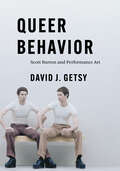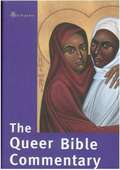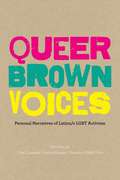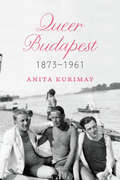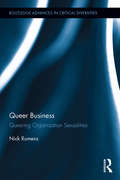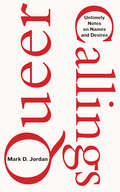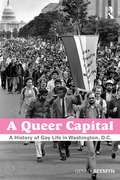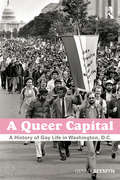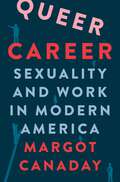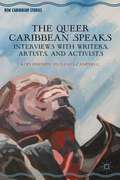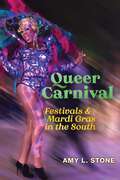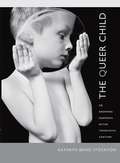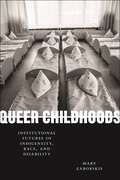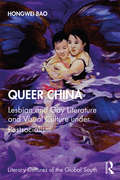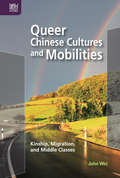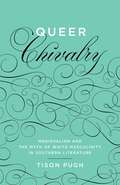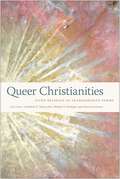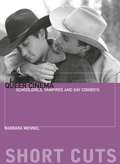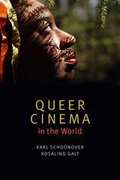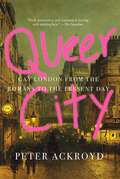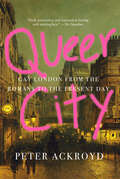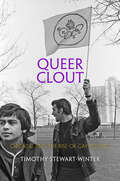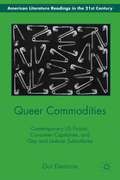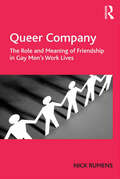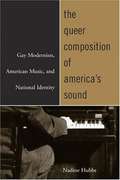- Table View
- List View
Queer Behavior: Scott Burton and Performance Art
by David J. GetsyThe first book to chart Scott Burton’s performance art and sculpture of the 1970s. Scott Burton (1939–89) created performance art and sculpture that drew on queer experience and the sexual cultures that flourished in New York City in the 1970s. David J. Getsy argues that Burton looked to body language and queer behavior in public space—most importantly, street cruising—as foundations for rethinking the audiences and possibilities of art. This first book on the artist examines Burton’s underacknowledged contributions to performance art and how he made queer life central in them. Extending his performances about cruising, sexual signaling, and power dynamics throughout the decade, Burton also came to create functional sculptures that covertly signaled queerness by hiding in plain sight as furniture waiting to be used. With research drawing from multiple archives and numerous interviews, Getsy charts Burton’s deep engagements with postminimalism, performance, feminism, behavioral psychology, design history, and queer culture. A restless and expansive artist, Burton transformed his commitment to gay liberation into a unique practice of performance, sculpture, and public art that aspired to be antielitist, embracing of differences, and open to all. Filled with stories of Burton’s life in New York’s art communities, Queer Behavior makes a case for Burton as one of the most significant out queer artists to emerge in the wake of the Stonewall uprising and offers rich accounts of queer art and performance art in the 1970s.
The Queer Bible Commentary
by Deryn Guest Robert E. Goss Mona West Thomas BohacheThis book brings together the work of several scholars and pastors known for their interest in the areas of gender, sexuality and Biblical studies. <p><p> Rather than a verse-by-verse analysis, typical of more traditional commentaries, contributors to this volume focus specifically upon those portions of the book that have particular relevance for readers interested in lesbian, gay, bisexual and transgender issues such as the construction of gender and sexuality, the reification of heterosexuality, the question of lesbian and gay ancestry within the Bible, the transgendered voices of the prophets, the use of the Bible in contemporary political, socio-economic and religious spheres and the impact upon lesbian, gay, bisexual and transgender communities. <p><p> Accordingly, the commentary raises new questions and re-directs more traditional questions in fresh and innovative ways, offering new angles of approach. This comprehensive, cutting-edge commentary is prefaced by an introductory essay by Professor Mary Tolbert. Contributors draw on feminist, queer, deconstructionist, utopian theories, the social sciences and historical-critical discourses. The focus is both how reading from lesbian, gay, bisexual and/or transgender perspectives affect the reading and interpretation of biblical texts and how biblical texts have and do affect lesbian, gay, bisexual and/or transgender communities. <p><p> The commentary includes an extensive bibliography that directs the reader to a full range of literature relating to queer interpretation of scripture.
Queer Brown Voices: Personal Narratives of Latina/o LGBT Activism (First Edition)
by Uriel QuesadaTo disrupt the cycle of sexism, racism, and homophobia that they experienced, LGBT Latinas/os organized themselves on local, state, and national levels, forming communities in which they could fight for equal rights while simultaneously staying true to both their ethnic and sexual identities.
Queer Budapest, 1873–1961
by Anita KurimayBy the dawn of the twentieth century, Budapest was a burgeoning cosmopolitan metropolis. Known at the time as the “Pearl of the Danube,” it boasted some of Europe’s most innovative architectural and cultural achievements, and its growing middle class was committed to advancing the city’s liberal politics and making it an intellectual and commercial crossroads between East and West. In addition, as historian Anita Kurimay reveals, fin-de-siècle Budapest was also famous for its boisterous public sexual culture, including a robust gay subculture. Queer Budapest is the riveting story of nonnormative sexualities in Hungary as they were understood, experienced, and policed between the birth of the capital as a unified metropolis in 1873 and the decriminalization of male homosexual acts in 1961. Kurimay explores how and why a series of illiberal Hungarian regimes came to regulate but also tolerate and protect queer life. She also explains how the precarious coexistence between the illiberal state and queer community ended abruptly at the close of World War II. A stunning reappraisal of sexuality’s political implications, Queer Budapest recuperates queer communities as an integral part of Hungary’s—and Europe’s—modern incarnation.
Queer Business: Queering Organization Sexualities (Routledge Advances in Critical Diversities)
by Nick RumensIn this modern day and age, it is surprising that managerialist perspectives, practices and ideas are colonising the study of sexualities in organisation. A timely intervention into the contemporary vitality of queer theories, Queer Business is an innovative book length exploration of how queer theory has been used in management and organisation studies, with the aim of broadening and deepening queer scholarship in this discipline. Through both scholarly and original empirical research, Rumens also seeks to demonstrate how queer theory has been mobilised in MOS and how it might be advanced in a field where it has yet to become exhausted and clichéd. In particular, this volume shows how scholars can use queer theory concepts to explore how lesbian, gay, bisexual and transgender sexualities and genders are understood and experienced in the workplace. Challenging notions of LGBT+ inclusivity in the workplace through concepts such as queer liberalism and homonormativity, Queer Business will appeal to scholars, undergraduate and postgraduate students and postdoctoral researchers interested in fields such as management and organisation studies, queer studies, gender studies, sexuality studies, organisational theory and cultural studies.
Queer Callings: Untimely Notes on Names and Desires
by Mark D. JordanA passionate exhortation to expand the ways we talk about human sex, sexuality, and gender.Twenty-five years ago, Mark D. Jordan published his landmark book on the invention and early history of the category “sodomy,” one that helped to decriminalize certain sexual acts in the United States and to remove the word sodomy from the updated version of a standard English translation of the Christian Bible. In Queer Callings, Jordan extends the same kind of illuminating critical analysis to present uses of “identity” with regard to sexual difference. While the stakes might not seem as high, he acknowledges, his newest history of sexuality is just as vital to a better present and future.Shaking up current conversations that focus on “identity language,” this essential new book seeks to restore queer languages of desire by inviting readers to consider how understandings of “sexual identity” have shifted—and continue to shift—over time. Queer Callings re-reads texts in various genres—literary and political, religious and autobiographical—that have been preoccupied with naming sex/gender diversity beyond a scheme of LGBTQ+ identities. Engaging a wide range of literary and critical works concerned with sex/gender self-understanding in relation to “spirituality,” Jordan takes up the writings of Oscar Wilde, Marcel Proust, Djuna Barnes, Samuel R. Delany, Audre Lorde, Geoff Mains, Eve Kosofsky Sedgwick, Gloria Anzaldúa, Maggie Nelson, and others.Before it’s possible to perceive sexual identities differently, Jordan argues, current habits for classifying them have to be disrupted. In this way, Queer Callings asks us to reach beyond identity language and invites us to re-perform a selection of alternate languages—some from before the invention of phrases like “sexual identity,” others more recent. Tracing a partial genealogy for “sexual identity” and allied phrases, Jordan reveals that the terms are newer than we might imagine. Many queer folk now counted as literary or political ancestors didn’t claim a sexual or gender identity: They didn’t know they were supposed to have one. Finally, Queer Callings joins the writers it has evoked to resist any remaining confidence that it’s possible to give neatly contained accounts of human desire. Reaching into the past to open our eyes to extraordinary opportunities in our present and future, Queer Callings is a generatively destabilizing and essential read.
A Queer Capital: A History of Gay Life In Washington D. C.
by Genny BeemynRooted in extensive archival research and personal interviews, A Queer Capital is the first history of LGBT life in the nation's capital. Revealing a vibrant past that dates back more than 125 years, the book explores how lesbians, gay men, and bisexuals established spaces of their own before and after World War II, survived some of the harshest anti-gay campaigns in the U. S. , and organized to demand equal treatment. Telling the stories of black and white gay communities and individuals, Genny Beemyn shows how race, gender, and class shaped the construction of gay social worlds in a racially segregated city. From the turn of the twentieth century through the 1980s, Beemyn explores the experiences of gay people in Washington, showing how they created their own communities, fought for their rights, and, in the process, helped to change the country. Combining rich personal stories with keen historical analysis, A Queer Capital provides insights into LGBT life, the history of Washington, D. C. , and African American life and culture in the twentieth century.
A Queer Capital: A History of Gay Life in Washington D.C.
by Genny BeemynRooted in extensive archival research and personal interviews, A Queer Capital is the first history of LGBT life in the nation’s capital. Revealing a vibrant past that dates back more than 125 years, the book explores how lesbians, gay men, and bisexuals established spaces of their own before and after World War II, survived some of the harshest anti-gay campaigns in the U.S., and organized to demand equal treatment. Telling the stories of black and white gay communities and individuals, Genny Beemyn shows how race, gender, and class shaped the construction of gay social worlds in a racially segregated city. From the turn of the twentieth century through the 1980s, Beemyn explores the experiences of gay people in Washington, showing how they created their own communities, fought for their rights, and, in the process, helped to change the country. Combining rich personal stories with keen historical analysis, A Queer Capital provides insights into LGBT life, the history of Washington, D.C., and African American life and culture in the twentieth century.
Queer Career: Sexuality and Work in Modern America
by Margot CanadayA masterful history of the LGBT workforce in AmericaWorkplaces have traditionally been viewed as “straight spaces” in which queer people passed. As a result, historians have directed limited attention to the experiences of queer people on the job. Queer Career rectifies this, offering an expansive historical look at sexual minorities in the modern American workforce. Arguing that queer workers were more visible than hidden and, against the backdrop of state aggression, vulnerable to employer exploitation, Margot Canaday positions employment and fear of job loss as central to gay life in postwar America.Rather than finding that many midcentury employers tried to root out gay employees, Canaday sees an early version of “don’t ask / don’t tell”: in all kinds of work, as long as queer workers were discreet, they were valued for the lower wages they could be paid, their contingency, their perceived lack of familial ties, and the ease with which they could be pulled in and pushed out of the labor market. Across the socioeconomic spectrum, they were harbingers of post-Fordist employment regimes we now associate with precarity. While progress was not linear, by century’s end some gay workers rejected their former discretion, and some employers eventually offered them protection unattained through law. Pushed by activists at the corporate grass roots, business emerged at the forefront of employment rights for sexual minorities. It did so, at least in part, in response to the way that queer workers aligned with, and even prefigured, the labor system of late capitalism.Queer Career shows how LGBT history helps us understand the recent history of capitalism and labor and rewrites our understanding of the queer past.
The Queer Caribbean Speaks
by Kofi Omoniyi Sylvanus CampbellIn most Caribbean countries homosexuality is still illegal and many outside of the region are unaware of how difficult life can be for gay men and lesbians. This book collects interviews with queer Caribbean writers, activists, and citizens and challenges the dominance of Euro-American theories in understanding global queerness.
Queer Carnival: Festivals and Mardi Gras in the South
by Amy L. StoneThe importance of citywide festivals like Mardi Gras and Fiesta for the LGBTQ communityFestivals like Mardi Gras and Fiesta have come to be annual events in which entire cities participate, and LGBTQ people are a visible part of these celebrations. In other words, the party is on, the party is queer, and everyone is invited. In Queer Carnival, Amy Stone takes us inside these colorful, eye-catching, and often raucous events, highlighting their importance to queer life in America’s urban South and Southwest. Drawing on five years of research, and over a hundred days at LGBTQ events in cities such as San Antonio, Santa Fe, Baton Rouge, and Mobile, Stone gives readers a front-row seat to festivals, carnivals, and Mardi Gras celebrations, vividly bringing these queer cultural spaces and the people that create and participate in them to life. Stone shows how these events serve a larger fundamental purpose, helping LGBTQ people to cultivate a sense of belonging in cities that may be otherwise hostile. Queer Carnival provides an important new perspective on queer life in the South and Southwest, showing us the ways that LGBTQ communities not only survive, but thrive, even in the most unexpected places.
The Queer Child: Or Growing Sideways in the Twentieth Century (Series Q)
by Kathryn Bond StocktonChildren are thoroughly, shockingly queer, as Kathryn Bond Stockton explains in The Queer Child, where she examines children’s strangeness, even some children’s subliminal “gayness,” in the twentieth century. Estranging, broadening, darkening forms of children emerge as this book illuminates the child queered by innocence, the child queered by color, the child queered by Freud, the child queered by money, and the grown homosexual metaphorically seen as a child (or as an animal), alongside the gay child. What might the notion of a “gay” child do to conceptions of the child? How might it outline the pain, closets, emotional labors, sexual motives, and sideways movements that attend all children, however we deny it? <P><P>Engaging and challenging the work of sociologists, legal theorists, and historians, Stockton coins the term “growing sideways” to describe ways of growing that defy the usual sense of growing “up” in a linear trajectory toward full stature, marriage, reproduction, and the relinquishing of childish ways. Growing sideways is a mode of irregular growth involving odd lingerings, wayward paths, and fertile delays. Contending that children’s queerness is rendered and explored best in fictional forms, including literature, film, and television, Stockton offers dazzling readings of works ranging from novels by Henry James, Radclyffe Hall, Virginia Woolf, Djuna Barnes, and Vladimir Nabokov to the movies Guess Who’s Coming to Dinner, The Hanging Garden, Heavenly Creatures, Hoop Dreams, and the 2005 remake of Willy Wonka and the Chocolate Factory. The result is a fascinating look at children’s masochism, their interactions with pedophiles and animals, their unfathomable, hazy motives (leading them at times into sex, seduction, delinquency, and murder), their interracial appetites, and their love of consumption and destruction through the alluring economy of candy.
Queer Childhoods: Institutional Futures of Indigeneity, Race, and Disability (Sexual Cultures)
by Mary ZaborskisExplores how the institutional management of children’s sexualities in boarding schools affected children’s future social, political, and economic opportunities Tracing the US’s investment in disciplining minoritarian sexualities since the late nineteenth century, Mary Zaborskis focuses on a ubiquitous but understudied figure: the queer child. Queer Childhoods examines the lived and literary experiences of children who attended reform schools, schools for the blind, African American industrial schools, and Native American boarding schools. In mapping the institutional terrain of queer childhoods in educational settings of the late nineteenth- and twentieth-century, the book offers an original archive of children’s sexual and embodied experiences. Zaborskis argues that these boarding schools—designed to segregate racialized, criminalized, and disabled children from mainstream culture—produced new forms of childhood. These childhoods have secured American futures in which institutionalized children (and the adults they become) have not been considered full-fledged citizens or participants. By locating this queerness in state archives and institutions, Queer Childhoods exposes a queer social history entangled with genocide, eugenics, and racialized violence.
Queer China: Lesbian and Gay Literature and Visual Culture under Postsocialism (Literary Cultures of the Global South)
by Hongwei BaoThis book analyses queer cultural production in contemporary China to map the broad social transformations in gender, sexuality and desire. It examines queer literature and visual cultures in China’s post-Mao and postsocialist era to show how these diverse cultural forms and practices not only function as context-specific and culturally sensitive forms of social activism but also produce distinct types of gender and sexual subjectivities unique to China’s postsocialist conditions. From poetry to papercutting art, from ‘comrade/gay literature’ to girls’ love fan fiction, from lesbian films to activist documentaries, and from a drag show in Shanghai to a public performance of a same-sex wedding in Beijing, the book reveals a queer China in all its ideological complexity and creative energy. Empirically rich and methodologically eclectic, Queer China skilfully weaves together historical and archival research, textual and discourse analysis, along with interviews and ethnography. Breaking new ground and bringing a non-Western perspective to the fore, this transdisciplinary work contributes to multiple academic fields including literary and cultural studies, media and communication studies, film and screen studies, contemporary art, theatre and performance studies, gender and sexuality studies, China/Asia and Global South studies, cultural history and cultural geography, political theory and the study of social movements.
Queer Chinese Cultures and Mobilities
by John WeiIn Queer Chinese Cultures and Mobilities, John Wei brings light to the germination and movements of queer cultures and social practices in today’s China and Sinophone Asia. While many scholars attribute China’s emergent queer cultures to the neoliberal turn and the global political landscape, Wei refuses to take these assumptions for granted. He finds that the values and pitfalls of the development-induced mobilities and post-development syndromes have conjointly structured and sustained people’s ongoing longings and sufferings under the dual pressure of compulsory familism and compulsory development. While young gay men are increasingly mobilized in their decision-making to pursue sociocultural and socioeconomic capital to afford a queer life, the ubiquitous and compulsory mobilities have significantly reshaped and redefined today’s queer kinship structure, transnational cultural network, and social stratification in China and capitalist Asia. With Queer Chinese Cultures and Mobilities, Wei interrogates the meanings and functions of mobilities at the forefront of China’s internal transformation and international expansion for its great dream of revival, when gender and sexuality have become increasingly mobilized with geographical, cultural, and social class migrations and mobilizations beyond traditional and conventional frameworks, categories, and boundaries.
Queer Chivalry: Medievalism and the Myth of White Masculinity in Southern Literature (Southern Literary Studies)
by Tison PughFor the U.S. South, the myth of chivalric masculinity dominates the cultural and historical landscape. Visions of white southern men as archetypes of honor and gentility run throughout regional narratives with little regard for the actions and, at times, the atrocities committed by such men. In Queer Chivalry, Tison Pugh exposes the inherent contradictions in these depictions of cavalier manhood, investigating the foundations of southern gallantry as a reincarnated and reauthorized version of medieval masculinity. Pugh argues that the idea of masculinity -- particularly as seen in works by prominent southern authors from Mark Twain to Ellen Gilchrist -- constitutes a cultural myth that queerly demarcates accepted norms of manliness, often by displaying the impossibility of its achievement. Beginning with Twain's famous critique of "the Sir Walter disease" that pilloried the South, Pugh focuses on authors who questioned the code of chivalry by creating protagonists whose quests for personal knighthood prove quixotic. Through detailed readings of major works -- including Twain's A Connecticut Yankee in King Arthur's Court, Flannery O'Connor's short fiction, John Kennedy Toole's A Confederacy of Dunces, Robert Penn Warren's A Place to Come To, Walker Percy's novels, and Gilchrist's The Annunciation -- Pugh demonstrates that the hypermasculinity of white-knight ideals only draws attention to the ambiguous gender of the literary southern male.Employing insights from gender and psychoanalytic theory, Queer Chivalry contributes to recent critical discussions of the cloaked anxieties about gender and sexuality in southern literature. Ultimately, Pugh uncovers queer limits in the cavalier mythos, showing how facts and fictions contributed to the ideological formulation of the South.
Queer Christianities: Lived Religion in Transgressive Forms
by Mark Larrimore Kathleen T. Talvacchia Michael F. PettingerQueerness and Christianity, often depicted as mutually exclusive, both challenge received notions of the good and the natural. Nowhere is this challenge more visible than in the identities, faiths, and communities that queer Christians have long been creating. As Christians they have staked a claim for a Christianity that is true to their self-understandings. How do queer-identified persons understand their religious lives? And in what ways do the lived experiences of queer Christians respond to traditions and reshape them in contemporary practice? Queer Christianities integrates the perspectives of queer theory, religious studies, and Christian theology into a lively conversation--both transgressive and traditional--about the fundamental questions surrounding the lives of queer Christians. The volume contributes to the emerging scholarly discussion on queer religious experiences as lived both within communities of Christian confession, as well as outside of these established communities. Organized around traditional Christian states of life--celibacy, matrimony, and what is here provocatively conceptualized as promiscuity--this work reflects the ways in which queer Christians continually reconstruct and multiply the forms these states of life take. Queer Christianities challenges received ideas about sexuality and religion, yet remains true to Christian self-understandings that are open to further enquiry and to further queerness.
Queer Cinema: Schoolgirls, Vampires, and Gay Cowboys (Short Cuts)
by Barbara MennelQueer Cinema: Schoolgirls, Vampires, and Gay Cowboys illustrates queer cinematic aesthetics by highlighting key films that emerged at historical turning points throughout the twentieth century. Barbara Mennel traces the representation of gays and lesbians from the sexual liberation movements of the roaring 1920s in Berlin to the Stonewall Rebellion in New York City and the emergence of queer activism and film in the early 1990s. She explains early tropes of queerness, such as the boarding school or the vampire, and describes the development of camp from 1950s Hollywood to underground art of the late 1960s in New York City. Mennel concludes with an exploration of the contemporary mainstreaming of gay and lesbian films and global queer cinema. Queer Cinema: Schoolgirls, Vampires and Gay Cowboys not only offers an introduction to a gay and lesbian film history, but also contributes to an academic discussion about queer subversion of mainstream film.
Queer Cinema in the World
by Karl Schoonover Rosalind GaltProposing a radical vision of cinema's queer globalism, Karl Schoonover and Rosalind Galt explore how queer filmmaking intersects with international sexual cultures, geopolitics, and aesthetics to disrupt dominant modes of world making. Whether in its exploration of queer cinematic temporality, the paradox of the queer popular, or the deviant ecologies of the queer pastoral, Schoonover and Galt reimagine the scope of queer film studies. The authors move beyond the gay art cinema canon to consider a broad range of films from Chinese lesbian drama and Swedish genderqueer documentary to Bangladeshi melodrama and Bolivian activist video. Schoonover and Galt make a case for the centrality of queerness in cinema and trace how queer cinema circulates around the globe-institutionally via film festivals, online consumption, and human rights campaigns, but also affectively in the production of a queer sensorium. In this account, cinema creates a uniquely potent mode of queer worldliness, one that disrupts normative ways of being in the world and forges revised modes of belonging.
Queer City: Gay London from the Romans to the Present Day
by Peter AckroydIn Queer City, the acclaimed Peter Ackroyd looks at London in a whole new way--through the complete history and experiences of its gay and lesbian population. In Roman Londinium, the city was dotted with qqlupannrin (“wolf dens” or public pleasure houses), qqforniees (brothels), and thermie (hot baths). Then came Emperor Constantine, with his bishops, monks, and missionaries. And so began an endless loop of alternating permissiveness and censure. Ackroyd takes us right into the hidden history of the city, from the notorious Normans to the frenzy of executions for sodomy in the early nineteenth century. He journeys through the coffee bars of sixties Soho to Gay Liberation, disco music, and the horror of AIDS. Ackroyd reveals the hidden story of London, with its diversity, thrills, and energy, as well as its terrors, dangers, and risks, and in doing so, explains the origins of all English-speaking gay culture. At the end of the book is an extensive and up-to-date bibliography that enables the reader to delve more deeply into homosexuality from the renaissance to today in England and in Europe. Peter Ackroyd is an award-winning historian, biographer, novelist, poet, and broadcaster. He is the author of the acclaimed nonfiction best sellers London: The Biography, Thames, and London Under, biographies of figures including Charles Dickens, William Blake, and Alfred Hitchcock; and a multivolume history of England. He has won the Whitbread Biography Award, the Guardian Fiction Prize, and the Somerset Maugham Award. He holds a CBE for services to literature.
Queer City: Gay London from the Romans to the Present Day
by Peter AckroydA history of the development of London as a European epicenter of queer life.In Queer City, the acclaimed Peter Ackroyd looks at London in a whole new way–through the complete history and experiences of its gay and lesbian population. In Roman Londinium, the city was dotted with lupanaria (“wolf dens” or public pleasure houses), fornices (brothels), and thermiae (hot baths). Then came the Emperor Constantine, with his bishops, monks, and missionaries. And so began an endless loop of alternating permissiveness and censure. Ackroyd takes us right into the hidden history of the city; from the notorious Normans to the frenzy of executions for sodomy in the early nineteenth century. He journeys through the coffee bars of sixties Soho to Gay Liberation, disco music, and the horror of AIDS. Ackroyd reveals the hidden story of London, with its diversity, thrills, and energy, as well as its terrors, dangers, and risks, and in doing so, explains the origins of all English-speaking gay culture.Praise for Queer City“Spanning centuries, the book is a fantastically researched project that is obviously close to the author’s heart…. An exciting look at London’s queer history and a tribute to the “various human worlds maintained in [the city’s] diversity despite persecution, condemnation, and affliction.””—Kirkus Reviews“[Ackroyd’s] work is highly anecdotal and near encyclopedic . . . the book is fascinating in its careful exposition of the singularities—and commonalities—of gay life, both male and female. Ultimately it is, as he concludes, a celebration as well as a history,” —Booklist“A witty history-cum-tribute to gay London, from the Roman “wolf dens” through Oscar Wilde and Gay Pride marches to the present day,” —ShelfAwareness
Queer Clout: Chicago and the Rise of Gay Politics
by Timothy Stewart-WinterIn postwar America, the path to political power for gays and lesbians led through city hall. By the late 1980s, politicians and elected officials, who had originally sought political advantage from raiding gay bars and carting their patrons off to jail, were pursuing gays and lesbians aggressively as a voting bloc—not least by campaigning in those same bars. Gays had acquired power and influence. They had clout.<P><P> Tracing the gay movement's trajectory since the 1950s from the closet to the corridors of power, Queer Clout is the first book to weave together activism and electoral politics, shifting the story from the coastal gay meccas to the nation's great inland metropolis. Timothy Stewart-Winter challenges the traditional division between the homophile and gay liberation movements, and stresses gay people's and African Americans' shared focus on police harassment. He highlights the crucial role of black civil rights activists and political leaders in offering white gays and lesbians not only a model for protest but also an opening to join an emerging liberal coalition in city hall. The book draws on diverse oral histories and archival records spanning half a century, including those of undercover vice and police red squad investigators, previously unexamined interviews by midcentury social scientists studying gay life, and newly available papers of activists, politicians, and city agencies.<P> As the first history of gay politics in the post-Stonewall era grounded in archival research, Queer Clout sheds new light on the politics of race, religion, and the AIDS crisis, and it shows how big-city politics paved the way for the gay movement's unprecedented successes under the nation's first African American president.
Queer Commodities
by Guy DavidsonQueer Commoditiesis the first book-length analysis of same-sexuality and consumer capitalism in contemporary US fiction. Moving beyond the critical tendencies to identify gay and lesbian subcultures as either hopelessly immersed in consumer capitalism or heroically resistant to it, Guy Davidson argues that while these subcultures are necessarily commodified, they also provide means of subversively negotiating aspects of life under capitalism.
Queer Company: The Role and Meaning of Friendship in Gay Men's Work Lives
by Nick RumensDrawn from in-depth qualitative research, Queer Company provides the first extended, academic analysis of gay men's workplace friendships, offering theoretical and empirical insights into a subject that is timely and important. Although theoretically framed in poststructuralism and the sociology of friendship, this book also draws on feminism, organisation studies, gender and sexuality studies to explore the diverse roles and meanings of gay men's workplace friendships. Shedding light on the significance of workplace friendship for those who participate in them, particularly in terms of how these workplace relationships can help gay men to construct meaningful identities and selves, Queer Company examines the manner in which gay men’s workplace friendships are established, developed and organised, whilst considering the effects of organisational contexts upon friendship processes. A detailed investigation of the links between friendship, sexuality, gender and intimacy in the workplace, this book will appeal to scholars of management studies as well as sociologists with interests in gender and sexuality, the sociology of organisations and cultural studies.
The Queer Composition of America's Sound: Gay Modernists, American Music, and National Identity
by Nadine HubbsNadine Hubbs shows how a gifted group of Manhattan-based gay composers were pivotal in creating a distinctive "American sound" and in the process served as architects of modern American identity. Focusing on a talented circle that included Aaron Copland, Virgil Thomson, Leonard Bernstein, Marc Blitzstein, Paul Bowles, David Diamond, and Ned Rorem, The Queer Composition of America's Sound homes in on the role of these artists' self-identification.
